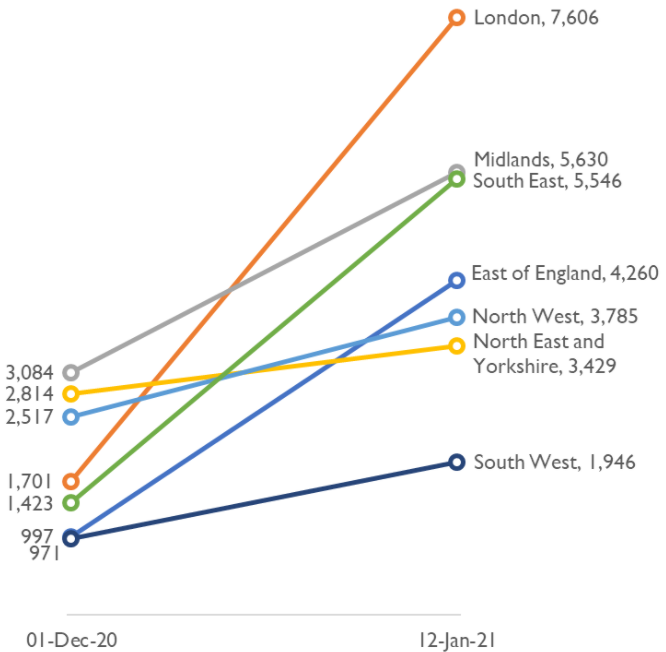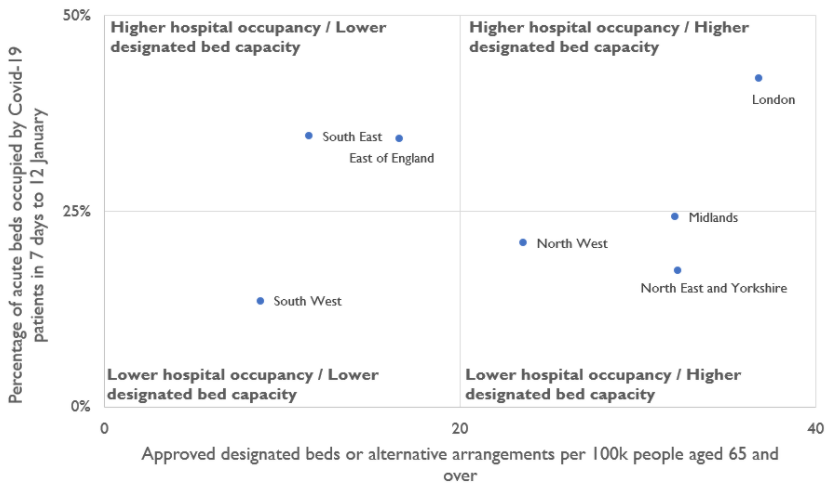In the last edition of this Insight series, we looked at the regional data we have on designated settings. These settings are intended for people who are discharged from hospital with a COVID-positive test who will be moving or going back into a care home setting. We also included ‘alternative settings’, where some local authorities have agreed with local NHS partners to make use of NHS settings to fulfil the role of a designated setting.
We provide a weekly update on the number of assured designated locations on this website.
Last month, we reported a wide variation in the number of beds in designated settings or alternative arrangements when compared with the number of older people and the ongoing rates of infection in each region.
Since our last report the emergence of a new variant of COVID-19, which is known to be more contagious, has seen infection rates rise dramatically, starting in the South East of England and rapidly spreading into other parts of the country from there. This has had a knock-on effect on admissions to hospitals since December and increased the already high pressure on the NHS and adult social care.
In this edition, we look at how the increase in COVID-19 hospital admissions compares with the overall capacity of beds in designated settings and alternative arrangements in each region of England. As levels of infection continue to increase, it is more likely that, for those who have tested positive, hospitals will need to access the capacity created by the designated setting scheme. This is as part of a wider consideration of people’s social care needs as they leave hospital, such as support for those who can go home with some care or reablement, and those who those who need a care home who can go directly to a bed.
Between 1 December 2020 and 12 January 2021, the number of acute hospital beds occupied by COVID-19 patients increased by around 138% nationally. The average COVID-19 occupancy rate was 27% in the seven days to 12 January, compared with 22% in the previous seven days. Two trusts currently have rates above 50%; more than half of their beds are occupied by patients with confirmed COVID-19.
The changes have varied considerably across regions (figure 1). Whereas, for example, the North East and Yorkshire saw a relatively small increase from 1 December 2020 to 12 January 2021, the South East, East of England and London have all seen very large increases. The number of acute beds occupied by COVID-19 patients in London more than quadrupled in the space of six weeks.

The marked increase in COVID-19 bed occupancy has not yet seen the same sort of increase in designated beds within these regions. As a result, there are local systems of note within the South East and East of England with higher COVID occupancy and lower rates of designated beds than other areas. In these areas there is a risk that people who have been identified as COVID positive and will be returning or moving into a care home may not be able to leave hospital in a timely way.

In the period 5 to 12 January 2021:
- The South West region had the lowest rate of designated beds per 100,000 people aged 65 and over than any other region. This situation was mitigated by having the lowest regional occupancy of hospital beds by COVID positive patients. Weekly rates of bed occupancy remained stable compared to the previous week.
- The South East had the second lowest rate of designated beds per 100,000 people aged 65 and over. The regional rate of COVID bed occupancy levels increased to 35% and remained in the top three in the country. This region may see local areas in which acute hospitals have fewer options to discharge COVID positive patients.
- The East of England saw a large proportional increase in COVID bed occupancy to 34% and had the third lowest rate of designated beds per 100,000 population aged 65 and over.
- London saw a notable increase in COVID bed occupancies to 42%. The region had the highest rate of COVID occupancy and the highest rate of designated beds per 100,000 people aged 65 and over, with a rate of 37. Individual acute hospitals have seen even greater increases in COVID occupancy.
- The Midlands had the fourth highest COVID hospital bed occupancy of the seven regions (24%) but the largest volume of designated beds. The 270 alternative arrangement beds in the Birmingham local authority made up a significant proportion of these. When looking at the average rate of designated beds per 100,000 of the population aged 65 and over, the Midlands had the third highest rate after London and North East and Yorkshire.
- North East and Yorkshire has seen a comparatively stable rate of COVID bed occupancy and had the second lowest regional level (17%). The average rate of designated beds per 100,000 people aged 65 and over was relatively high and the second highest across the English regions.
- The North West had a regional rate of COVID bed occupancy at 21%, but a lower rate of designated beds per 100,000 people aged 65 and over (24) compared to Midlands and North East and Yorkshire.
This is a very fast-moving situation. This analysis of the capacity of regional health and adult social care systems to support increasing numbers of people who are COVID-positive aims to highlight some of the challenges that local systems face. It should support conversations happening locally between local system stakeholders, trusts and local authorities as to plans for expanding a range of solutions (including designated beds), making sure these can be fully deployed, and developing any alternative arrangements for COVID-positive people coming out of hospital who need social care support.
Read more...
Download the report
You can download a version of this report if you want to print or share it with your team.
Related news
You can also read our news stories about the publication of these reports:
Previous issue
You can read the issue of the report that we published in December. This issue looked at designated settings and care home capacity as well as our provider collaboration reviews.